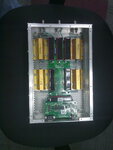S
slow_rider
Guest
Hello All,
I'm building an impedance box to test an amplifier (box with resistors that can be switched in series and out of the circuit to represent different impedances between the input and output terminals). Resistors are from 15 Ohm up to 200 Ohm.
The resistors that are being used are Arcol NHS100 type which are pure resistors, tested with our impedance analyzer from 100KHz to 2MHz. Our amplifier is working at 500KHz and outputs up to 50W on various impedances.
The input & output to this box is a standard coax cable, however only the inner conductor is used and the shield is connected to the box shield to prevent crosstalk between channels, however there is no "return current" on this outer conductor so the cable is acting like a coil and adds about 40 degrees phase shift which is easily correctable using a proper capacitor.
As you can see in the picture, the resistors are set around the PCB that houses a small controller IC and reed relays to switch the resistors in and out of the circuit. When I switch a resistor in (especially the larger ones, 100 and 200 Ohms) they also seem to be coils adding up to 20 degrees phase shift. I wish I could say the "coil effect" each one has is additive, however it is not. So I can not simply match each resistor with a small capacitor is series and solve the problem.
Another thing that is interesting to note is that this exact same circuit with the same PCB housed inside a plastic box does not suffer from these effects (almost at all). This is the very first project I am doing with RF and have no experience. So if anyone could direct me to a solution I will greatly appreciate it.
I'm building an impedance box to test an amplifier (box with resistors that can be switched in series and out of the circuit to represent different impedances between the input and output terminals). Resistors are from 15 Ohm up to 200 Ohm.
The resistors that are being used are Arcol NHS100 type which are pure resistors, tested with our impedance analyzer from 100KHz to 2MHz. Our amplifier is working at 500KHz and outputs up to 50W on various impedances.
The input & output to this box is a standard coax cable, however only the inner conductor is used and the shield is connected to the box shield to prevent crosstalk between channels, however there is no "return current" on this outer conductor so the cable is acting like a coil and adds about 40 degrees phase shift which is easily correctable using a proper capacitor.
As you can see in the picture, the resistors are set around the PCB that houses a small controller IC and reed relays to switch the resistors in and out of the circuit. When I switch a resistor in (especially the larger ones, 100 and 200 Ohms) they also seem to be coils adding up to 20 degrees phase shift. I wish I could say the "coil effect" each one has is additive, however it is not. So I can not simply match each resistor with a small capacitor is series and solve the problem.
Another thing that is interesting to note is that this exact same circuit with the same PCB housed inside a plastic box does not suffer from these effects (almost at all). This is the very first project I am doing with RF and have no experience. So if anyone could direct me to a solution I will greatly appreciate it.


